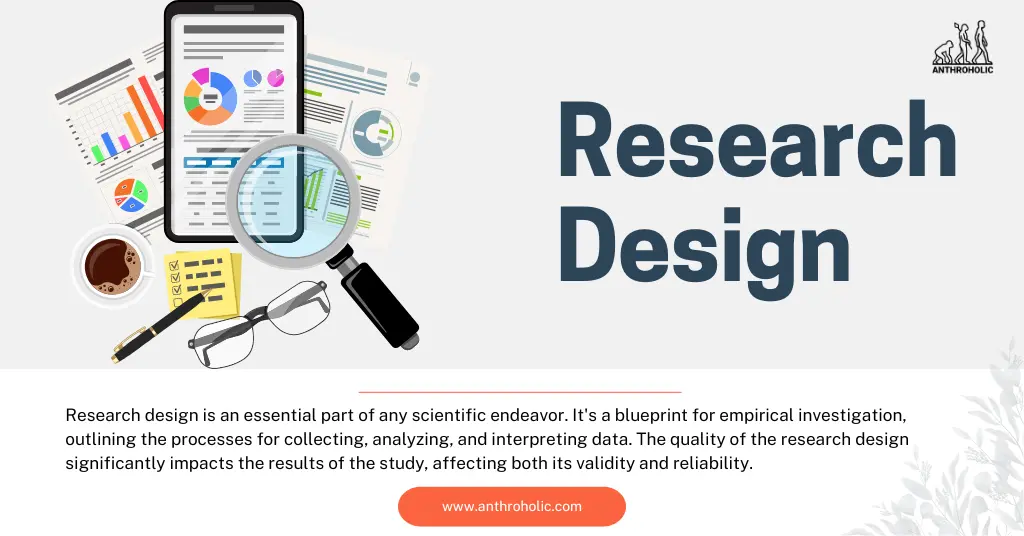
Research design is an essential part of any scientific endeavor. It’s a blueprint for empirical investigation, outlining the processes for collecting, analyzing, and interpreting data [1]. The quality of the research design significantly impacts the results of the study, affecting both its validity and reliability.

Research designs can be broadly classified into three categories:
The four key components of a research design include:
Table 1: Components of Research Design
| Component | Description |
|---|---|
| Purpose of the Study | Defines why the research is being conducted |
| Type of Investigation | Determines if the study is correlational or causal |
| Researcher Control | Shows the level of manipulation by the researcher |
| Time Dimension | Indicates if the study is cross-sectional or longitudinal |
Selecting the correct research design is crucial for the success of any research study. Here are few tips to make the right choice:
Each research design has its strengths and weaknesses:
Descriptive Design
Experimental Design
Correlational Design
An increasingly popular approach to research design is the mixed-methods design. This involves integrating both qualitative (focused on understanding and interpretation) and quantitative (centered on testing and measurement) research [11].
The advantages of mixed-methods designs include:
However, there are also challenges associated with mixed-methods designs, such as additional resources required and the need for expertise in both qualitative and quantitative methods [13].
Regardless of the chosen research design, it’s vital that all researchers adhere to ethical standards. Some key ethical considerations include:
The future of research design is dynamic and evolving. With advancements in technology, researchers have more tools at their disposal. This will potentially lead to new types of research design, particularly in fields like data science, bioinformatics, and other interdisciplinary areas.
Emerging trends include the use of big data, artificial intelligence, and virtual reality in research designs. For example, the use of AI in experimental designs to identify optimal experimental conditions [16].
A well-designed research study provides a robust foundation for data collection and analysis, helping researchers draw meaningful conclusions. By understanding the different types of research designs and their components, researchers can make informed choices about their studies. In choosing a research design, it’s essential to keep in mind the study’s goals, resources available, and ethical considerations.
[1] Creswell, J. W., & Creswell, J. D. (2017). Research design: Qualitative, quantitative, and mixed methods approaches. Sage publications.
[2] Robson, C., & McCartan, K. (2016). Real world research. Wiley.
[3] Campbell, D. T., & Stanley, J. C. (2015). Experimental and quasi-experimental designs for research. Ravenio Books.
[4] Shadish, W. R., Cook, T. D., & Campbell, D. T. (2002). Experimental and quasi-experimental designs for generalized causal inference. Houghton, Mifflin and Company.
[5] Babbie, E. (2015). The Practice of Social Research. Cengage Learning.
[6] Neuman, W. L. (2013). Social research methods: Qualitative and quantitative approaches. Pearson Education.
[7] Israel, M., & Hay, I. (2018). Research ethics for social scientists. Sage.
[8] Neuman, W. L. (2013). Social research methods: Qualitative and quantitative approaches. Pearson Education.
[9] Shadish, W. R., Cook, T. D., & Campbell, D. T. (2002). Experimental and quasi-experimental designs for generalized causal inference. Houghton, Mifflin and Company.
[10] Field, A. (2013). Discovering statistics using IBM SPSS statistics. Sage.
[11] Creswell, J. W., & Clark, V. L. P. (2017). Designing and conducting mixed methods research. Sage publications.
[12] Johnson, R. B., Onwuegbuzie, A. J., & Turner, L. A. (2007). Toward a definition of mixed methods research. Journal of mixed methods research, 1(2), 112-133.
[13] Tashakkori, A., & Teddlie, C. (2010). SAGE handbook of mixed methods in social & behavioral research. Sage.
[14] Beauchamp, T. L., & Childress, J. F. (2013). Principles of biomedical ethics. Oxford University Press.
[15] Israel, M., & Hay, I. (2018). Research ethics for social scientists. Sage.
[16] M. Zaharia, M. Chowdhury, T. Das, A. Dave, J. Ma, M. McCauley, M. J. Franklin, S. Shenker, I. Stoica. (2016). Resilient distributed datasets: A fault-tolerant abstraction for in-memory cluster computing. In Proceedings of the 9th USENIX conference on Networked Systems Design and Implementation (NSDI’12). USENIX Association.